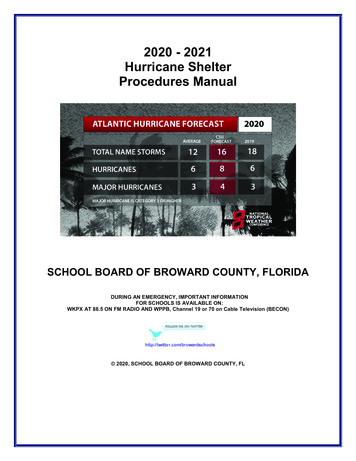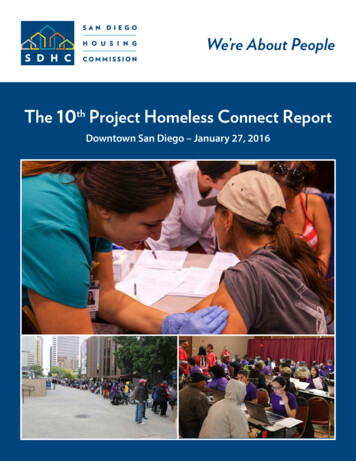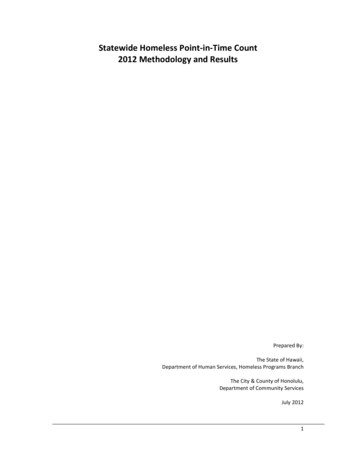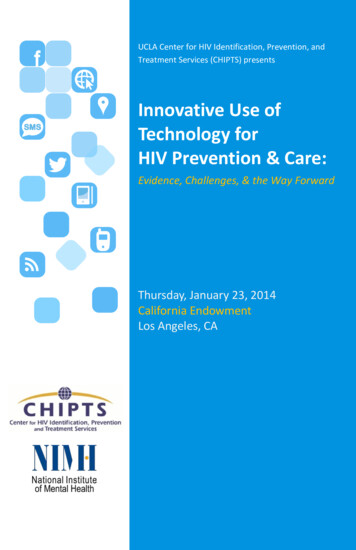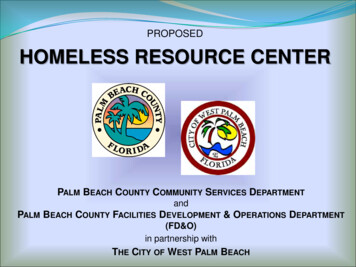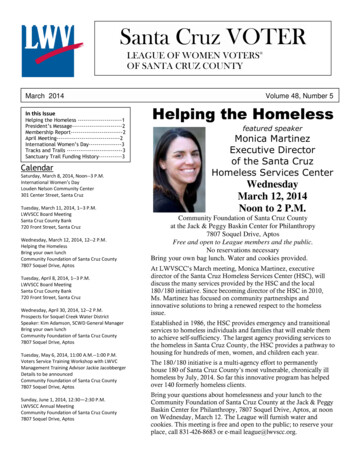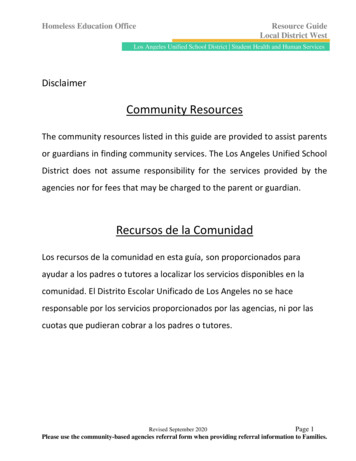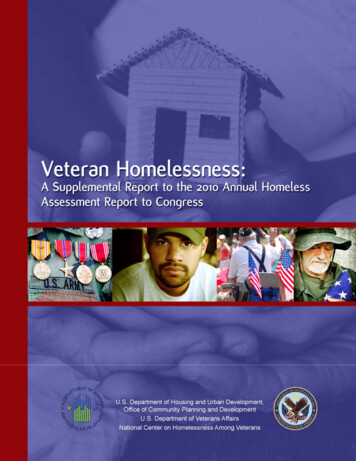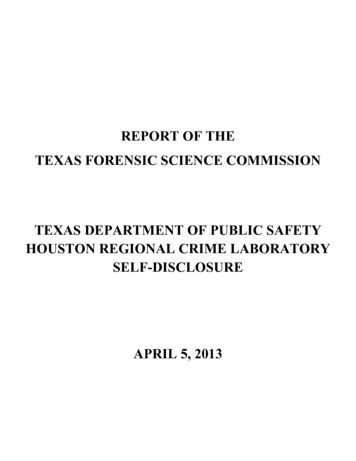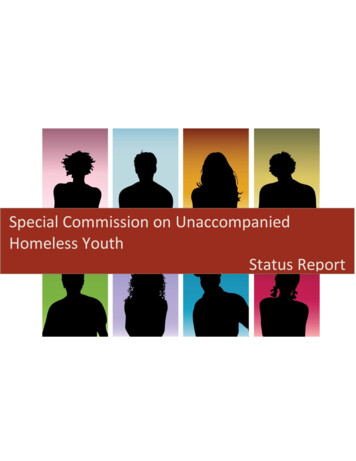
Transcription
Special Commission on UnaccompaniedHomeless YouthStatus Report
Special Commission on Unaccompanied Homeless Youth: Status ReportContentsExecutive Summary . 2Identification and Connection . 4Barriers to Serving Youth Under Age 18. 7Services for Lesbian, Gay, Bisexual, Transgender,Queer, and/or Questioning Youth . 9General Services and Housing . 12Appendix A: Authorizing Legislative Language . 15Appendix B: Members of the Commission . 16I WANT TO GET A JOB AND ANAPARTMENT. I JUST WISH THEREWAS MORE HOUSING AVAILABLE.—YOUTH TESTIMONYJanuary 2014Executive Office of Health and Human Services1
Special Commission on Unaccompanied Homeless Youth: Status ReportExecutive Summary“I didn’t really have a choice. My parents said I was no longer welcome in their house and sothen I didn’t have a home anymore. It was pretty simple, you know?”—Youth testimonyThe Special Commission on Unaccompanied Homeless Youth (the Commission) was establishedthrough Outside Section 208 of the FY2013 Budget, signed into law on July 8, 2012. TheCommission was charged with researchingand making recommendations relative toservices for unaccompanied homelessyouth1, with the goal of ensuring acomprehensive and effective response tothe unique needs of this population. Thelegislation required that the Commission’swork include: (i) an analysis of barriers toserving unaccompanied youth who aregay, lesbian, bisexual, transgender; (ii) an analysis of barriers to serving unaccompanied youthunder age 18; (iii) an assessment of the impact of mandated reporting requirements on youths’access to services; (iv) an assessment of the Commonwealth’s ability to identify and connectwith unaccompanied youth; and (v) recommendations to reduce identified barriers to servingthis population.In order to accomplish this task, the Commission convened four Working Groups to investigateand respond to the issues. The Commission’s Working Groups include: 1) Identification andConnection; 2) Barriers to Serving Youth Under Age 18; 3) Barriers and Services for Lesbian, Gay,Bisexual, Transgender, Queer, and/or Questioning (LGBTQ) Youth; and 4) General Services andHousing.As Massachusetts continues to make strides in addressing the needs of some of theCommonwealth’s most vulnerable youth, the Commission is pleased to be able to submit thisstatus report on our first full year of work. Through the efforts of the Commission,Massachusetts has executed its first-ever statewide census of youth experiencing homelessness.This first-in-the-nation initiative will allow the Commonwealth to begin to appropriately gaugeboth the scope of need and types of services these young people may require. LGBTQ-identified1The Commission defined “Unaccompanied Homeless Youth” as: A person 24 years of age oryounger who is not in the physical custody or care of a parent or legal guardian and who lacks afixed, regular, and adequate nighttime residence.January 2014Executive Office of Health and Human Services2
Special Commission on Unaccompanied Homeless Youth: Status Reportyouth in particular, who may require specific services (particularly for transgender youth), willhave their responses closely analyzed in the review of census data.Over the course of the year the Commission has conducted research, interviewed staff fromstate and community-based agencies, and interviewed current and former unaccompaniedhomeless youth in order to better understand youth homelessness and its underlying causes.Additionally, the Working Groups identified barriers that prevent young people from accessingservices in the current system, such as the relationship between service providers and themandated reporting law, and began to compile an audit of resources and service modelsavailable to unaccompanied homeless youth.In the previous report the Commission issued a series of recommendations that were intendedto guide its work over the course of the months to follow. This report serves as a status updateon the first full year of the Commission’s activities to implement or further the work of thoserecommendations, and to identify and support youth experiencing homelessness. However, welook forward to submitting a subsequent report when the census data, outlined in theIdentification and Connection section, has been fully analyzed.January 2014Executive Office of Health and Human Services3
Special Commission on Unaccompanied Homeless Youth: Status ReportIdentification and ConnectionThe Identification and Connection WorkingGroup is charged with assessing theCommonwealth’s ability to identify andconnect with unaccompanied homelessyouth and capturing an accurate count ofunaccompanied young people who areexperiencing homelessness in theCommonwealth.Recent ActivitiesRecommendation: Develop a uniform survey tool for statewide use.Since the previous report, the Working Group began their work by reviewing survey tools usedin other communities and analyzing the effectiveness of these tools to determine the mostuseful and effective approach for conducting a survey of unaccompanied homeless youth. TheWorking Group reviewed a variety of surveys, including survey tools from the Worcester TeenHousing Task Force, the City of Boston, the Massachusetts Housing and Shelter Alliance, theDistrict of Columbia, the D.C. Alliance of Youth Advocates, and Applied Survey Research (aconsultant group whose work has been highlighted by the U.S. Interagency Council onHomelessness and the National Alliance to End Homelessness). The initial review was conductedprimarily by Amanda Benton, an intern from Harvard University’s Kennedy School ofGovernment, with input from other Working Group members. The group assessed aspects ofthe tools including length, types of questions, strategies for de-duplication, languageaccessibility, format, and style of administration.The Working Group decided to use the Worcester and Boston survey tools as starting points forcreating a statewide youth homelessness survey tool. The group worked from the December2012 Boston version, and made changes based on promising practices identified through theiranalysis, as well as information garnered by the Urban Institute’s analysis of the U.S.Department of Housing and Urban Development’s 2013 “Youth Count!” pilot. Over six months,the tool was revised to incorporate feedback from a variety of stakeholders, includingCommission members, youth-serving providers, Continuum of Care members, andunaccompanied homeless youth. Valuable feedback from youth and young adults was gatheredduring a series of focus groups conducted this fall on behalf of the Commission by the ExecutiveOffice of Health and Human Services and the Massachusetts Coalition for the Homeless, as wellas through written questionnaires distributed by providers to youth in their programs. The toolis now complete and was translated into Spanish by Justice Resource Institute for use during thestatewide count that took place in January 2014. JRI also provided translation services forHaitian-Creole, Portuguese, and Khmer, but due to late adjustments to the tool thesetranslations were not able to be finalized. The Working Group has identified this as an area forJanuary 2014Executive Office of Health and Human Services4
Special Commission on Unaccompanied Homeless Youth: Status Reportimprovement in future counts to ensure adequate assessment of non-English speaking youthexperiencing homelessness.Recommendation: Outline a robust youth engagement strategy.The Working Group considered its responsibilities for outlining a youth engagement strategy intwo ways: 1) ensuring youth engagement in the Working Group process; and 2) ensuring youthengagement in the administration of a statewide census. First, the group wanted to be sure thatas they were planning strategies for conducting a count and survey that they were incorporatingyouth voices and perspectives into those plans. The Working Group agreed it was critical thatthe approach to counting unaccompanied homeless youth be culturally sensitive and accessible,and consider the diverse circumstances of youth experiencing homelessness. As such, theWorking Group partnered with youth-serving providers to conduct a series of focus groups togather input into the survey tool and methodology. Those focus groups, along with somewritten feedback, have informed specific aspects of the tool to help ensure it will collectaccurate information.Second, the group has developed a methodology for conducting the statewide count that isbased upon robust engagement of unaccompanied homeless youth. Youth were engaged asvolunteers during the count, helping to identify locations where unaccompanied homelessyouth can be identified, and administering the survey. The Working Group has prioritizedresources to support stipends for youth volunteers, and for paying stipends to youth whocomplete the survey. Additional details on the methodology can be found below.Recommendation: Evaluate potential strategies for creating useful typologies of youth.Activities related to this recommendation have not yet been implemented. The Working Groupagreed that developing potential typologies (profiles or categories of unaccompanied homelessyouth) could not be considered until after the statewide census data is analyzed, so that anysuch typologies will reflect the demographics of youth experiencing homelessness here inMassachusetts and will help to guide service delivery. The Working Group anticipates revisitingthis recommendation following breakdown of the results of the youth census.Recommendation: Leverage existing counting efforts to pilot implementation of statewidecensus of unaccompanied homeless youth.The Working Group has developed a methodology for conducting a statewide census and surveyof unaccompanied homeless youth. In the state’s fiscal year 2014 budget, 150,000 wasprovided to support the census. The methodology consists of two components: 1) a basic censuscount on the night of the annual HUD Point-in-Time (PIT) Count in communities across the state;and 2) a more detailed demographic and service and housing need survey to be conducted inthe week following the PIT Count.January 2014Executive Office of Health and Human Services5
Special Commission on Unaccompanied Homeless Youth: Status ReportBoth aspects were implemented by leveraging the existing infrastructure of the 18 localContinua of Care (CoC)2. Each CoC has been offered a one-time capacity building grant in theamount of 4,750 to support costs associated with implementing the Massachusetts YouthCount. Boston conducted their PIT Count in December, and all other CoCs conducted theirs inJanuary. In addition, CoCs received technical assistance from the Working Group to sharepromising practices and ensure standard application of the methodology across sites.On November 18, 2013, the Working Group held a half-day conference on the MassachusettsYouth Count effort. A total of 75 people attended, with all 18 CoCs represented. A Google Grouphas also been established to assist in creating a learning community amongst thoseimplementing the count. Additional materials, research, and discussion will be shared via thegroup.Upcoming ActivitiesIn the coming year the Identification and Connection Working Group intends to analyze the datafrom the youth census and submit a summary report on the effort to the full Commission andother interested stakeholders.Members of the Identification and Connection Working Group Co-Chair Liz Rogers, Interagency Council on Housing HomelessnessCo-Chair Kelly Turley, Massachusetts Coalition for the HomelessLauren Almquist, MassHealthMaurie Bergeron, LUK, Inc.Carly Burton, Mass EqualityAlice Colegrove, Department of Public HealthMarc Dones, Program Manager, Office of Children, Youth, and FamiliesCaitlin Golden, Massachusetts Housing and Shelter AllianceExa Méndez, Massachusetts Coalition for the HomelessJoan Meschino, Massachusetts Appleseed Center for Law and JusticeLiz Peck, Massachusetts Alliance on Teen PregnancySarah Slautterback, Department of Elementary and Secondary EducationLinn Torto, Department of Housing and Community DevelopmentYonina Wanderer, Massachusetts Appleseed Center for Law and JusticeThe Identification and Connection Working Group has been aided by the additional expertise ofDr. Laurie Ross of Clark University, Danielle Ferrier of Justice Resource Institute, and AmandaBenton, formerly of the National Alliance to End Homelessness.2CoCs are HUD-funded local homelessness prevention and intervention service areas that arealso responsible for administering the PIT Counts.January 2014Executive Office of Health and Human Services6
Special Commission on Unaccompanied Homeless Youth: Status ReportBarriers to Serving Youth Under Age 18The Barriers to Serving Youth Under Age 18Working Group is charged with cataloguing thebarriers, both in regulation and in statute, whichmay unintentionally prevent unaccompanied youthfrom seeking or obtaining services. The WorkingGroup was also directed to research and discussmandatory reporting of child abuse and neglectand licensing provisions that may impact theprovision of services to unaccompanied homelessyouth.Recent ActivitiesRecommendation: Evaluate current training programs for all mandatory reporters; andenhance the working relationship between community providers, schools, and state agenciesserving unaccompanied homeless youth.In the past year, the Working Group developed a plan for exploring the relationship betweenservice barriers and mandated reporting. Mandated reporting plays a vital role in connectingvulnerable youth to essential support services, and it is critical to understand the barriers toconnecting youth to these services. Effective implementation of mandated reporting dependsnot only on appropriate training, but on the nature and quality of the working relationship thatexists among community providers and schools, i.e., mandated reporters, and those stateagencies to whom they are obligated to report. The Working Group’s proposed investigation isdesigned to better understand the underlying relationship and flow of information betweenreporters and those to whom reports are made.Initial recommendations made in the Commission’s first Report focused, in part, on training formandatory reporters. The Working Group believes that understanding potential challenges andcurrent practices around mandated reporting is a prerequisite for making recommendationswith respect to such training. This will not only enable recommendations to be made regardingtraining methods on mandated reporting, but will also help formulate steps that can be taken tostrengthen and enhance the working relationships among agencies and individuals directlyinteracting with young people and children.Upcoming activitiesIn the upcoming year, the Barriers Working Group intends to: Begin analysis of the ability to share protected information between theDepartment of Children and Families (DCF) and the schools regarding mandatoryreporting, as explained above.Conduct a review of best practices and additional literature on mandated reportingfrom around the country.January 2014Executive Office of Health and Human Services7
Special Commission on Unaccompanied Homeless Youth: Status Report Develop, together with the Working Group on Services for Lesbian, Gay, Bisexual,Transgender, Queer, and/or Questioning (LGBTQ) Youth an extension of the DESE /DCF project to explore information sharing related to mandated reporting in otherservice provider contexts.Review the survey findings from the youth census coordinated by the Identificationand Connection Working Group to inform the continuing work being undertaken bythe Barriers Working Group.Conduct additional research in order to identify specific barriers to service provisionarising from legal frameworks related to confidentiality obligations.Members of the Barriers to Service for youth under age 18 Working Group: Chair, Joan Meschino, MA Appleseed Center for Law and JusticeKhadejah Ahmad, Office of Rep. James O’DayMaurie Bergeron, LUKAnn Capoccia, Department of Mental HealthMarc Dones, Program Manager, Office of Children, Youth, and FamiliesKate Federici, Department of Mental HealthDanielle Ferrier, Re-discovery / Justice Resource Institute and the Task Force on YouthAging OutYonina Hoffman-Wanderer, MA Appleseed Center for Law and JusticeAyala Livny, Youth on FireExa Méndez, Massachusetts Coalition for the HomelessMaureen Messeder, Department of Children and FamiliesDanielle Morrow, Office of Rep. James O’DayAmy Mullen, Department of Children and FamiliesRepresentative James O’DayKelly Turley, Massachusetts Coalition for the HomelessJanuary 2014Executive Office of Health and Human Services8
Special Commission on Unaccompanied Homeless Youth: Status ReportServices for Lesbian, Gay, Bisexual, Transgender, Queer, and/orQuestioning YouthThe Services for Lesbian, Gay, Bisexual,Transgender , Queer, and/or Questioning(LGBTQ) Youth Working Group is charged withan analysis of the specific needs of and barriersfacing lesbian, gay, bisexual, transgender,queer, and/or questioning unaccompaniedyouth experiencing homelessness, as well asrecommending any specific service deliveryalternatives that may be needed to addressthese barriers.Recent ActivitiesRecommendation: Increase the number of LGBTQ-specific services.The data from the youth census filled out by LGBTQ identifying young people will be analyzed tobegin a process of service delivery design.In the interim the Working Group will be studying the implementation and results of the newLGBTQ-specific units and services being provided through the Massachusetts Housing andShelter Alliance (MHSA) Home & Healthy for Good program. This program received 200,000 inthe FY14 state budget to provide a pilot program for LGBTQ young adults who are experiencingchronic homelessness. Using low-threshold permanent supportive housing to address chronichomelessness, this pilot will place young adults in permanent housing with developmentallyappropriate support services. MHSA is working with three service providers for this pilot: JusticeResource Institute in Boston, the AIDS Action Committee’s Youth on Fire program in Cambridge,and DIAL/SELF Youth & Community Services in Greenfield. The LGBTQ Working Group willcontinue to work with MHSA to track this program and provide information about its success ina subsequent report.Recommendation: Increase LGBTQ-inclusive data collection across all youth-serving stateagencies.Collecting data on LGBTQ youth is a very complex undertaking. Each youth-serving state agency(even all of those within EOHHS) collects different pieces of data. Additionally, the methodologyfor collecting that data differs among agencies, and sharing of data across agencies can bechallenging from an information technology and legal perspective. Along with the Commissionon Lesbian, Gay, Bisexual, and Transgender Youth, which counsels state agencies about how tobetter serve LGBTQ youth, this Working Group has recommended specifically to the Departmentof Children and Families, the Department of Youth Services and the Department of Elementaryand Secondary Education ways to improve how they collect data on LGBTQ youth. Theseagencies were selected based on their direct provision of services to young people. This effortJanuary 2014Executive Office of Health and Human Services9
Special Commission on Unaccompanied Homeless Youth: Status Reportmeans revising forms, training staff to ask questions about sexual orientation or gender identityin a culturally competent way and/or creating the opportunity for a young person to selfdisclose. All three agencies have implemented or are in the process of implementing somechanges to improve their data collection around clients who are LGBTQ.This past spring, a question was added to the Massachusetts version of the Youth Risk BehaviorSurvey (YRBS) about gender identity, making that survey trans-inclusive. The Commonwealth isnow one of the first states to do this, and address one of the major gaps in data collection, thelack of data about the transgender population specifically. The YRBS data about gender identitycan be coupled with the data around housing and homelessness and will give us a betterunderstanding about the number of transgender young people who are experiencinghomelessness. This data will be available later this year.Members of the LGBTQ working group participated in the efforts of the Identification andConnection working group to develop a fully inclusive survey to be used in the statewide count.The current survey includes four questions on sexual orientation and gender identity. Once thatdata is analyzed, it can be compared to what is learned from the state agencies and gain insightabout who or who is not being appropriately served and why.Recommendation: Increase LGBTQ cultural competency training and awareness campaignswithin agencies.Executive Office of Health and Human Services (EOHHS) agencies understand the need forcultural competency training. In the past, EOHHS agencies have offered cultural competencytraining to staff through contracts with outside agencies or through internal training teams.However, through focus groups and conversations with youth-serving providers the WorkingGroup has heard that these trainings are not always regularly offered, tailored to particular staffmembers (e.g. frontline workers who may have an initial interaction with an LGBTQ youth) or ascomprehensive as possible. There are multiple reasons for training gaps but one is a lack of bothfinancial and training resources. Various agencies have begun to address this need throughrenewed or expanded contracting with outside organizations to provide training to select staff.The Executive Office of Health and Human Services is also working on adding LGBTQ culturalcompetency to the core trainings it provides to all EOHHS staff. If this effort is successful, itcould be a model for other secretariats.Upcoming ActivitiesIn the upcoming year the Services for LGBT Youth Working Group intends to: Continue working with MHSA to track the Home & Healthy for Good pilot program forLGBTQ young adults.Continue to partner with the LGBTQ Youth Commission – and specifically the agencyrelations subcommittee – to monitor the success and effectiveness of the training.Partner with the Barriers for Youth Under 18 Working Group to research mandatoryreporting both in Massachusetts and outside of the Commonwealth.January 2014Executive Office of Health and Human Services10
Special Commission on Unaccompanied Homeless Youth: Status Report Analyze data from the statewide youth census and the youth focus groups about thenumbers of LGBTQ youth identified, and whether they are accessing services.Members of the Services for Lesbian, Gay, Bisexual, and/or Transgender Youth Working Group Chair, Carly Burton, MassEqualityLauren Almquist, MassHealthSenator Harriet ChandlerTim Daley, Office of Senator Harriet ChandlerMarc Dones, Program Manager, Office of Children, Youth, and FamiliesCaitlin Golden, Massachusetts Housing and Shelter AllianceHannah Hussey, Massachusetts Commission on LGBTQ YouthCathy Kristofferson, Get EqualDiamond McMillian, Youth on FireLaura PaladinoGrace Sterling Stowell, Boston Area Gay, Lesbian, Bisexual and Transgender YouthBobbi Taylor, Massachusetts Transgender Political CoalitionJorgette Theophilis, Justice Resource InstituteKelly Turley, Massachusetts Coalition for the HomelessAllison Wright, Gay & Lesbian Advocates & DefendersJanuary 2014Executive Office of Health and Human Services11
Special Commission on Unaccompanied Homeless Youth: Status ReportGeneral Services and HousingThe General Services and Housing Working Group ischarged with examining the reports of the otherWorking Groups and creating a preliminary list ofrecommended services and housing interventions.These services and housing interventions may includeaugmentations to existing services or novelapproaches that would begin to create theCommonwealth’s systemic response to the issue ofunaccompanied youth homelessness.Recent ActivitiesRecommendation: Perform an analysis of existingresources by service types and use this information to assess for gaps.The Working Group has gathered information from programs and providers around theCommonwealth. The Working Group is specifically requesting information about the servicesand housing options that are available and gaps seen, as well as programmatic informationregarding specific populations served, costs, funding streams, and measures of success. Throughthe efforts of the Working Group, a number of critical findings have emerged. To date there hasnot been a comprehensive audit of services, including housing options, available tounaccompanied homeless youth in the Commonwealth. Services for unaccompanied homelessyouth, including housing, have not been evaluated to see if they are responsive to the expressedneeds of young people. Moreover, services, including housing, for unaccompanied homelessyouth have also not been evaluated for their adherence to best or promising practices or theirability to generate successful outcomes for youth. The Working Group will compile best andpromising practices and then move forward with sharing this information.To address the need for information, this year the Commission has supported a number ofactivities including focus groups of youth. This effort identified a lack of youth-focused, lowthreshold supportive emergency and transitional housing opportunities. The Working Groupalso heard that there was a shortage of supportive transitional housing or permanent housingopportunities at all threshold levels. In response to this, the Commission will design a modelcontinuum of supportive housing program models to meet the range of unique needs ofunaccompanied youth. The continuum will include the many different types of housing modelsthat can meet the needs of this population, including host homes, housing subsidies, clusteredand scattered site housing models, and vouchers, and should include the utilization of currentprograms, including those of the CoCs. The Working Group intends to design a system thatfacilitates a youth’s ability to become independent, self-sufficient and not rely on federally orstate-funded services, whenever possible.The Working Group is in the process of compiling an initial list of services, including housingoptions, available to unaccompanied homeless youth through a more formal request forinformation. A full budget impact analysis is also in process in partnership with the SimmonsJanuary 2014Executive Office of Health and Human Services12
Special Commission on Unaccompanied Homeless Youth: Status ReportCollege School of Management. Once the information has been gathered and compiled theWorking Group will partner with the Identification and Connection Working Group to create adraft model of recommended services, with budget requirements, using the census data toapproximate the appropriate scale of the system.Upcoming Activities Conduct additional analysis on service gaps that are not well understood but have beenraised by various community stakeholders and youth. These are: Lack of CORI “friendly”services for youth with criminal histories, licensing requirements/restrictions forprograms with youth under 18, lack of emergency shelter beds, lack of services forimmigrant/undocumented youth/youth with limited English proficiency, lack of servicesfor youth aging out of systems (DCF, DYS, DMH), lack of services for youth with specialneeds, as defined by an Individual Education Plan (IEP), lack of services forunaccompanied homeless youth in school, insufficient services for youth with mentalhealth and/or substance abuse issues, lack of or insufficient services forpregnant/parenting youth, lack of services specifically for trafficked/exploited youth. Review possible policy changes and adjustments to increase access to services andhousing. For example, there is a reported inability to obtain a valid ID due to thedifficulty in producing the necessary documentation necessary to get a valid ID. The costof the ID can also prove to be a financial barrier to young people (both amending an IDand applying for a new ID are 25). In addition, a lack of access to transportation foryoung people can cause difficulty securing employment or attending educationalprogramming, as well as accessing services. Review and make specific policy and regulatory recommendations to be included in thenext report to ensure that unaccompanied homeless youth have priority access tomainstream benefits and service resources for which they are eligible. Review and make specific policy and regulatory recommendations to housing partnersto insure that unaccompanied homeless youth have access to mainstream housingresources, both capital and operating as needed. Finalize a list of services and housing options and review to identify gaps. Finalize a services and housing model and a model budget in partnership with SimmonsCollege School of Management. Recommend a comprehensive services and housing continuum model once allinformation has been acquired.January 2014Executive Office of Health and Human Services13
Special Commission on Unaccompanied Homeless Youth: Status ReportMembers of the General Services and Housing Working Groups include: Co-Chair, Lisa Goldsmith, DIAL/SELF Youth and Community ServicesCo-Chair, Danielle Ferrier, Rediscovery/JRI, Taskforce on Youth Aging OutMaurie Bergeron, LUKStephanie Brown, Department of Transitional AssistanceAnn Capoccia, Department of Mental HealthSenator Harriette ChandlerMarc Dones, Prog
Alice Colegrove, Department of Public Health Marc Dones, Program Manager, Office of Children, Youth, and Families Caitlin Golden, Massachusetts Housing and Shelter Alliance Exa Méndez, Massachusetts Coalition for the Homeless Joan Meschino
